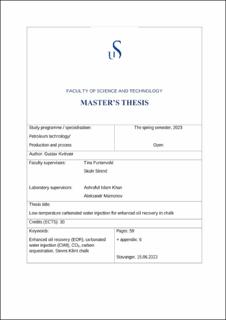| dc.description.abstract | The oil industry is still an essential contributor to meeting the continuously increasing global energy demands. As the world looks towards reaching carbon neutrality, new approaches and innovative ideas have never been more important. The best way of minimizing emissions while simultaneously meeting energy demands is to exploit the full potential of mature oil reservoirs close to depletion.
Carbon, capture, use and storage (CCUS) allows for the utilization of these reserves while aligning with the carbon neutrality goals. The use of CO2 as an enhanced oil recovery (EOR) technique is therefore more relevant than ever, as it can be used for carbon sequestration whilst simultaneously improving recovery rate. Pure CO2 injection, as a conventional EOR technique, has undergone extensive testing at both laboratory and reservoir scale. However, it encounters challenges in achieving optimal sweep efficiency. This is primarily due to the low viscosity of CO2 compared to crude oil, resulting in poor mobility ratio.
An emerging EOR technique involves the dissolution of CO2 in water, leading to the formation of a single phase known as carbonated water (CW). The premise of the experimental study is the utilization of CW for EOR. The core material used was the Stevns Klint (SK) chalk outcrop samples, which works as an analogue for North Sea chalk reservoirs, mainly the Ekofisk field.
In total, five cores were used for this study. The oil recovery tests were done through forced imbibition (FI) at both high pressure and low pressure, different injection modes and different temperatures. The effect of acid number (AN) on the wettability was examined. The wettability of two of the cores was measured through spontaneous imbibition (SI) and both exhibited similar slightly water wet characteristics. This suggests that the preparation process was good and that it could work as a wettability representation of the other three cores.
Results from the SI were compared to different oils with lower AN, and the results indicated that the AN directly influences the wettability of the carbonate rock. The oil with lower AN exhibited stronger water wet characteristic. This is in line with previous studies conducted on the matter.
This study found no evidence of temperature effect on total oil recovery during FI when comparing injection at 70℃ and 130℃. The amount of CO2 dissolved in the water did not seem to influence the total recovery, as the trend was similar for the high-pressure set-up compared to the low-pressure set-up. Injecting CW in secondary or tertiary mode did not influence the total recovery, %OOIP, but secondary mode injection required less water injection, therefore less water treatment, thus more economical and environmentally viable.
The main mechanism in this study for carbonated water injection (CWI) seemed to be wettability alteration. The total recovery was similar for experiments with different AN of oil, but the direct recovery from CWI in tertiary mode was higher for the core that had a higher AN and exhibited less natural water wet characteristics before the FI test. | |
